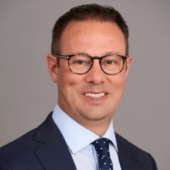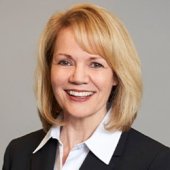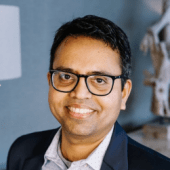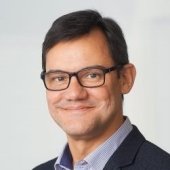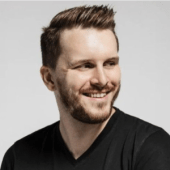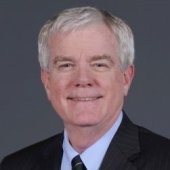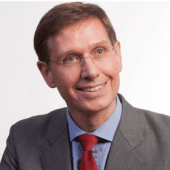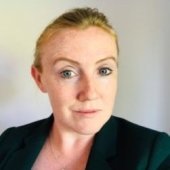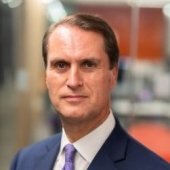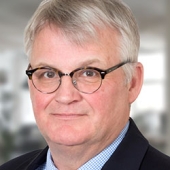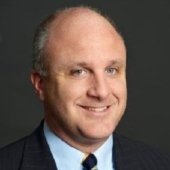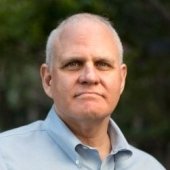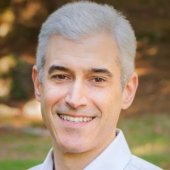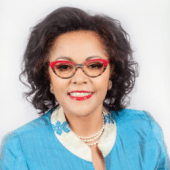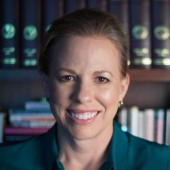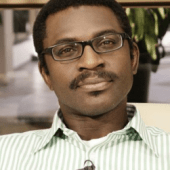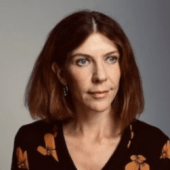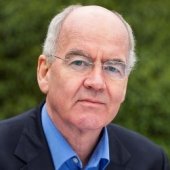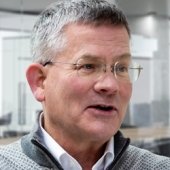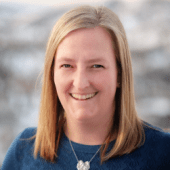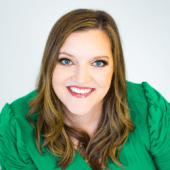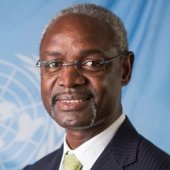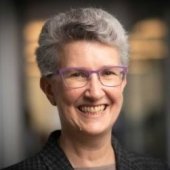IN BRIEF
- 5:03 – You don’t have to compromise your returns in order to do well in the world, and to do the right thing by society and your community, and to align your investment objectives to do well with your personal objectives to do good.
- 7:02 – Boomers have kids now who are 35 and 40 years old who really care about these things and are articulate about it, vocal about it, in a way that boomers may not have been, and they are certainly putting their money where their mouth is.
- 14:15 – The S is quickly becoming the D … Be proactive about thinking about diversity within your organization: What does it look like? How are you leveraging it? How are you creating an environment where everybody has equal access to opportunity?
Bob Hirth, Senior Managing Director at Protiviti and co–vice chair of the Sustainability Accounting Standards Board, sits down with Carla Harris, Vice Chair for Wealth Management at Morgan Stanley, to talk about ESG – where we’ve been, where we are going, and who is leading in this new urgent reality that companies are facing today.
Carla Harris is a Vice Chairman of Wealth Management, Managing Director and Senior Client Advisor at Morgan Stanley. She was most recently a Vice Chairman responsible for increasing client connectivity and penetration to enhance revenue generation across the firm. She formerly headed the Emerging Manager Platform, the equity capital markets effort for the consumer and retail industries and was responsible for Equity Private Placements. Harris has had extensive industry experiences in technology, media, retail, telecommunications, transportation and more.
Bob Hirth is a Senior Managing Director at Protiviti and provides a broad array of senior leadership and counsel in the areas of internal control, internal audit, people development, client relationships and revenue growth. Bob was one of the founding managing directors of Protiviti at its inception in 2002. He was appointed to the standard setting board of the Sustainability Accounting Standards Board (SASB) upon its formation in 2017 and serves as a vice chair of the board. He currently heads SASB’s Technology and Communications sector committee.
Video transcript
Joe Kornik: Welcome to the VISION by Protiviti interview. I’m Joe Kornik, Editor-in-Chief of VISION by Protiviti, our content initiative where we look into the future and examine the strategic implications of big topics that will impact business in 2030 and beyond.
Today, we’re exploring ESG and all its implications for employees, employers and customers. We’ve got an outstanding guest today as we welcome Carla Harris back to the program. Carla is Vice Chair of Wealth Management and senior client adviser at Morgan Stanley. She was chair of the Morgan Stanley Foundation from 2005 to 2014, and sits on the boards of several community organizations. In 2013, Carla was appointed by President Barack Obama to chair the National Women’s Business Council. She’s a renowned public speaker who offers guidance to corporate audiences based on her book, Expect to Win. I’m happy today to pass off the interviewing duties to my colleague Bob Hirth. Bob is a senior managing director at Protiviti and co–vice chair of the Sustainability Accounting Standards Board. Bob?
Bob Hirth: Carla, thanks for joining us today.
Carla Harris: Thanks for having me, Bob.
Bob Hirth: I’d like to discuss this new acronym we have, ESG — environmental, social and governance. The way we’re going to take this topic today, we’re going to go broad, and then we’re going to narrow it down in terms of your views, so I’d like to start with this notion of “fad, fiction or for real.” What do you think about this ESG movement?
Carla Harris: It is for real. It is definitely not a fad, because it’s been around — and certainly, Morgan Stanley has been prosecuting this space for around 11 years. It’s definitely not fiction, because we all have been in this environment where we’ve had tornadoes in places where we’ve never seen them before. We’ve had severe weather over the last decade in general, away from the tornadoes, so it is definitely real.
Bob Hirth: We’re going to get to Morgan Stanley, and we’ll get to wealth and management, but what do you think ESG is doing to companies themselves as organizations?
Carla Harris: Companies are transforming the way they do business, the way they use space, the way they use resources. They are very focused on their carbon footprint. The fact that shareholders are asking companies about it and companies are proactively reporting on their carbon footprint, what they’re doing around the world, how they are managing and integrating sustainability throughout their organization from supply chain to distribution to customer engagement, it is transforming the ways companies do business and the way that they speak externally to their consumers as well as their shareholders. No question about it, Bob.
Bob Hirth: Great. I’d like to move over to where you work every day, which is Morgan Stanley. We’ll get to wealth management and your role there in that part of the business, but what are you seeing happening at Morgan Stanley, the organization, as a result of ESG?
Carla Harris: Well, we’ve had several initiatives, frankly, where we have focused our population on decreasing their use of plastics. We have also created a bit of a lab for early-stage companies, that are creating companies around solutions with respect to the environment and sustainability, and we are funding some of those companies. We’ve created portfolios for our customers and clients who are focused in this area so that they can align their investment objectives with their personal interests and their personal objectives and goals, so there are a number of things that we are doing.
We’re walking the talk in terms of what we put in the cafeteria and how we orient people to behave while they’re within Morgan Stanley, as well as our challenges and initiatives that we have for while they’re in the building and while they’re outside of the building, and making sure that we are available to our clients who have the same concerns and objectives.
Bob Hirth: That’s a great point. People sometimes keep thinking about the downside and the risks of ESG, the climate, and you brought up a really good point in terms of the opportunities, and you’re right — all the new products that will come out of this.
I understand that you have a chief sustainability officer, I believe, at Morgan Stanley. Has that officer come to see you yet?
Carla Harris: I’ve worked very closely with that officer, Audrey Choi, for a very long time, since she’s been at Morgan Stanley, so I could not be more proud of what Audrey and her team have done and, frankly, what the firm has done. We have led in this space. Frankly, Bob, when people were just starting to have a conversation — “Can you do well and do good at the same time?” — we were making the case back then. And the rest of the industry has now come to us, that you don’t have to compromise your returns in order to do well in the world, and to do the right thing by society and your community, and to align your investment objectives to do well with your personal objectives to do good.
Bob Hirth: Great. I know you serve as vice chair for the wealth management business at Morgan Stanley. Let’s go to that business itself. You’re serving clients. You’re looking at investments. How is this ESG topic now getting considered or driven into the wealth management part of the bank?
Carla Harris: The easiest thing that I can point you to is the fact, as I mentioned earlier, that we have products that are specifically tied to our customer objectives. If you want to make sure that you have a portfolio that has no tobacco, no alcohol, no firearms, we’ve been able to do that for a long time. But today, if you want to have a portfolio that focuses on water and sustainability of water or decreasing the amount of plastic use or you name it — all the different subverticals within the larger vertical of sustainability — we can customize portfolios for individual clients as well as for institutions around those things. As I said, we were one of the first firms able to do that, and we’re leading in that space today.
Bob Hirth: Right. Another one of the terms that’s come out of this ESG movement is stakeholders. One of the stakeholders we see, back to your wealth management business, is the customer themselves. What kind of feedback or demand or interest are you getting from the individual customer that you serve in your wealth management business?
Carla Harris: The demand has been increasing over the last 10 years, for sure, and in the last five years, you’ve seen it exponentially grow. Part of that, frankly, Bob, is that millennials and Z-ers are quickly becoming the dominant population in the workforce. So, even the ultrawealthy who happen to be boomers or X-ers, guess what? They have kids now who are 35 and 40 years old who really care about these things and are articulate about it, vocal about it, in a way that boomers may not have been, and they are certainly putting their money where their mouth is.
You’re going to continue to see that desire or that demand for these kinds of products grow. The other thing that you see going on, frankly, is that in the institutional-investor community, those portfolio managers are shifting as well, so the next generation of portfolio managers is now getting into those seats at some of the larger asset management firms, and they care very much about this space as well.
Bob Hirth: As you think about the executives that serve your customers in wealth management and now we have this new topic of ESG, do you have a view that there are new skills needed or not new skills needed or some technical information they need? What’s your view of what the individual wealth management executive needs with respect to ESG?
Carla Harris: Well, I think the industry around ESG is continuing to evolve, and so I think that the objective, or the imperative, for leaders in the space is to continue to consume the knowledge and to have the posture of leading in the space, pushing the edge of the envelope and bringing your customers and clients along with you.
Bob Hirth: Great. Any interview today would be incomplete if we didn’t talk about technology. What’s happening with the use of technology and ESG at Morgan Stanley?
Carla Harris: Frankly, because of the COVID-19 crisis in particular, Bob, what I see across the industry and not just with us, is that I would argue before the COVID-19 crisis, we were all using technology. Now, I would argue that we are leveraging it, and we’re leveraging it in ways — like the way we’re talking, for example, now. Especially, if you take the wealth management business, for example, it used to be the case that you might sit down with your clients once a year, twice a year, once a quarter — depending on what the client’s needs were — physically, and that was the only way to do it. Now, you have tremendous leverage to be able to meet with a client. I met with my own adviser this morning using this technology, and she’s across the country in California.
It is changing the way we engage with our clients. It’s changing the way that we can distribute information. It’s changing the way we can educate our clients about what’s going on in the broader community. What I saw also over the COVID-19 crisis is, at a place like Morgan Stanley, we have access to a lot of information with respect to what’s going on broadly.
And in an environment full of uncertainty, there was so much information that we were generating about what was transpiring, how fast the virus was spreading around the country and around the world, what the handicap was around vaccines and what that might look like. Our biotech analyst on the institutional side of the business led, with respect to his voice, throughout this crisis especially when we were in the days of true-true uncertainty. That was information that was obviously publicly distributed, but that we could also synthesize and share with our clients in a high value-add way, and those are some of the things that you will see coming out of this that we will be able to leverage going forward.
Bob Hirth: Yes. You mentioned millennials and Gen Zs, and let’s think about the fairly recent or new college graduate. Is ESG a new opportunity for them?
Carla Harris: Yes, it’s a new opportunity. I say it’s part of their DNA, Bob. They have grown up in an environment where this is a conversation that is around them, and if you talk to any person that’s 19 or 28 and you start engaging them in the conversation about the environment, they’re going to be far more articulate and have an opinion in a way that I would argue a boomer might not. If you start talking to them about diversity — because I feel strongly that the S is quickly becoming the D; the social is definitely about diversity — it’s something that they care about. It’s in their DNA. Just look at who was in the streets this time last year. The social unrest and what we saw was actually led by a lot of millennials and Z-ers. They were looking at boomers saying, “Really? You guys are still having this conversation about this? What’s the problem?” So, I think very much so, they care about this space, and it’s not a new opportunity. It’s table stakes — that’s probably the best way to put it, Bob.
Bob Hirth: I know a large organization like Morgan Stanley hires graduates coming from the universities. Do you have a view? Are the universities doing much? Enough? What else do they need to do to maybe even change their curriculum around ESG?
Carla Harris: It’s funny you should say that because I happen to be on the board of overseers at Harvard as you know, and I see universities also being very vocal and articulate about what they’re doing around ESG and how they are embracing it, and I do think as people are thinking about joining certain institutions as a freshman or later-stage undergraduate, that’s something that they’re looking at, and I will tell you that as someone who went to college in the ’80s, it was not part of my report card in terms of criteria for the schools that I was going to go to.
Bob Hirth: Carla, you know that the ESG topic, in many people’s view, has a very long-term nature. Organizations are setting goals that aren’t just out there for one quarter or one year. They’ve set goals that may go all the way out to a decade or, for example, to 2030. What’s your long-term view or vision of ESG in 2030, for example?
Carla Harris: ESG is here to stay as a topic, and it’s something that shareholders will care about. You will continue to see it evolve. I can’t tell you exactly where it will be with 2030, but I’ll give you this perspective: Ten years ago the whole debate was, “Can you really do well by doing good?” and people were talking about eliminating things like tobacco and alcohol and firearms. That was the conversation. Now, the conversation has evolved to water, climate, plastics, diversity, and so it’s going to continue to evolve. If we look out nine years from now to 2030, almost a decade to 2030, you will continue to see that evolve.
The reason why companies are putting long-term goals out there is that it does take some time to implement these kinds of changes and, more importantly, to evaluate the strategies that you deploy. It won’t just turn up in a year, especially if you’re trying to decrease your carbon footprint significantly or go to zero carbon, for example, from wherever you are now. The good news is that we will have clear report cards with which to evaluate who has done what and who the winner is a decade from now.
Bob Hirth: I want to be sure that we covered everything about ESG that you wanted to cover, so is there any closing comment or little tidbit you’d like to give the audience today?
Carla Harris: I would refer back to the point that I just made, Bob: The S is quickly becoming the D. While companies are going to be tasked with talking about ESG, especially to their shareholders — because every shareholder is asking about it, whether it’s an institutional shareholder or a family office or a high-net-worth individual — companies are going to really need to focus on the S becoming the D. Be proactive about thinking about diversity within your organization: What does it look like? How are you leveraging it? How are you creating an environment where everybody has equal access to opportunity? That’s how you’ll get outside productivity, which obviously will drive both your top and your bottom line and your customer engagement. It’s something that I would leave your audience to think about as they move forward.
Bob Hirth: That’s great advice, Carla. Thanks again so much for joining us today.
Carla Harris: Thank you for having me, Bob.
Joe Kornik: Thanks, Bob. Thanks, Carla, for that insightful discussion. Carla, thank you so much for being on the program today. We’ll see you again next time.
Did you enjoy this content? For more like this, subscribe to the VISION by Protiviti newsletter.


